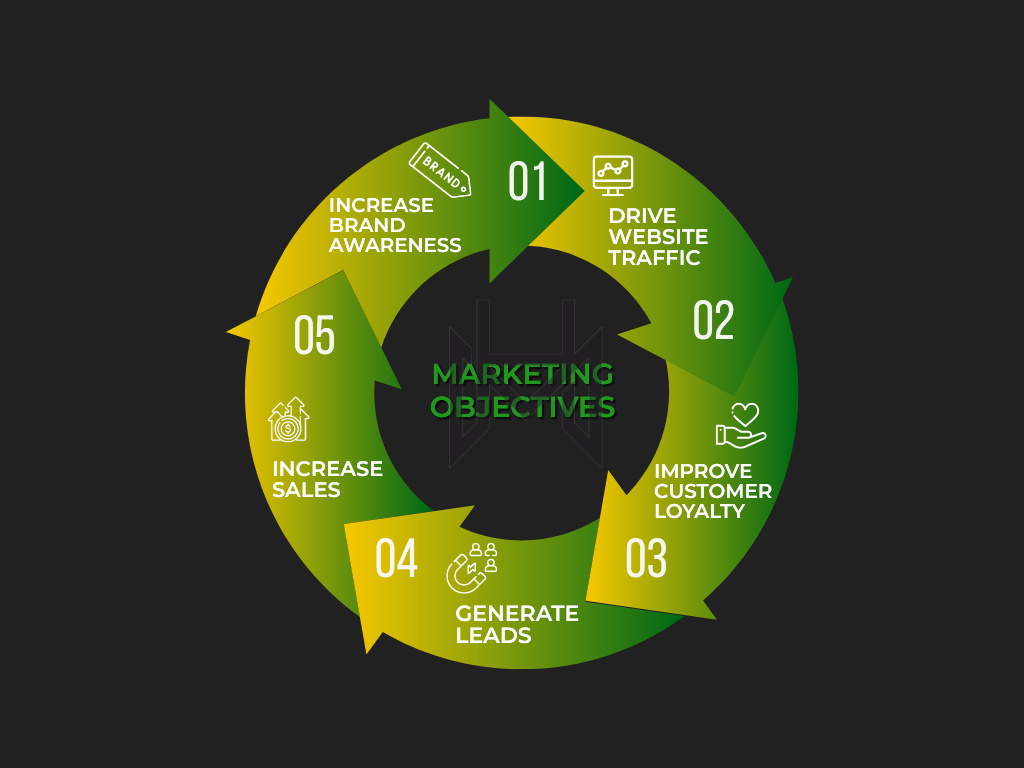
How to Plan, Measure, and Achieve Your Advertising Objectives
Hello, Hyrolian! Here we are again. It’s time for a little learning with Alex. Today, boys and girls, I’m going to talk about your advertising objectives.
I’ve said it before, and I will say it again. Aim at nothing, hit nothing. You have to know exactly where you’re taking aim. And this doesn’t happen by chance. You need a plan.
Have you ever shot a bow and arrow? Seriously. What happened the very first time you drew the bow and let ’er fly? I bet you nailed that bullseye. You were incredible. And on the second try, you hit it again. You were awesome.
Right. My guess is that you didn’t even hit the target. What’s worse is that you probably nailed the inside of your elbow. That hurts, doesn’t it? It leaves a nasty bruise, too.
You need help if you want to nail the bullseye. You need the right gear. You need the right technique. You need some pointers. You need a good plan if you want to consistently hit the center of your target.
Take that fantastic analogy and apply it to advertising. If your entire plan consists of “We’re gonna put a post on social media and get tons of traction!” well … that’s not a plan. That’s a thought. But it has no plan. You can’t measure it. And you don’t even have an objective.
Let’s get into the nitty-gritty.

As an advertiser, you know the importance of setting objectives. But how do you go about achieving them in a clear and organized way? How do you aim your arrow in a way that hits your target every time? Advertising can be complicated, with ever-shifting trends and an endless array of metrics to consider.
Planning and measuring your advertising efforts is extremely important when you want to make sure that you are reaching your desired outcomes. Assigning specific goals to each advertising campaign allows you to track the results and adjust your strategy accordingly. With the right planning, measuring, and goal-setting techniques in place, you can more effectively reach your desired objectives.
If you are a marketer who wants to get the most out of every ad campaign, having a comprehensive plan for planning, measuring, and achieving your advertising goals is key.
Here’s the deal. Advertising campaigns have revolutionized the way businesses reach out to customers. Whether it’s a traditional print ad or a digital marketing campaign, the goal is always to get your message across in an effective and memorable way.
But if your goals aren’t accurately defined, then your advertising efforts will be fruitless. Therefore understanding what goes into setting proper advertising objectives is a must when you want to put together a winning strategy.
Now, I know that setting advertising objectives can be intimidating if you don’t understand what needs to be done to ensure its success. That’s why I’m going to walk through each step of creating an effective plan from start to finish by exploring what goes into setting goals, developing strategies, selecting appropriate channels, and measuring results. With these tips and tricks, anyone can build out a comprehensive ad campaign that produces desired outcomes on any budget!
Advertising Objectives

Advertising objectives are essential for any business, large or small. They provide a way to measure the success of your advertising campaigns and ensure that you are spending the right amount of money on the right channels.
Before setting your advertising objectives, it is important to be realistic about your expectations. Advertising objectives by nature can be a bit nebulous, so it is important to set achievable goals that will help you reach your desired outcome.
When determining your advertising objectives, consider what you want to achieve with each ad campaign.
- Do you want to increase brand awareness?
- Generate more leads?
- Increase sales?
Once you have identified these goals, you need to create specific metrics that will help you track progress and measure success. For example, if you want to increase brand awareness, set a goal for how many people should become aware of your product or service within a certain time frame. If you want to generate more leads, set a goal for how many leads should be generated within a certain time frame.
By taking these steps and tracking progress along the way, you can ensure that your advertising efforts are successful and that they help you reach your desired outcome.
Primary Purpose of Advertising
The primary purpose of advertising is to increase sales and revenue, penetrate new markets, build brand awareness and loyalty, and improve customer relationships. To achieve these goals, companies must develop effective advertising campaigns that target specific audiences with tailored messages.
Tactics such as television commercials, radio spots, print ads, online ads, direct mailers, and more can be used to reach potential customers in a variety of ways. Companies should also consider using social media platforms to reach their target audience in order to maximize their return on investment.
Ultimately, it is important for companies to have a clear understanding of their marketing objectives before they begin developing their advertising plans in order to ensure that they are able to effectively reach their desired audience.
Objectives Must Be Realistic

It’s more important than ever for marketers to set objectives that are realistic, while at the same time challenging enough to drive growth. To achieve this balance, you should focus on creating objectives that are both measurable and achievable while also taking into account customer feedback and insights.
Additionally, as a marketer, you should ensure that your objectives are aligned with your overall business strategy so you can be sure that you are working towards achieving your desired outcomes.
Setting Objectives Can Be Tricky
Setting objectives in the advertising and marketing industry can be a pretty darn tricky endeavor. On one hand, setting ambitious goals can help to motivate your team and keep your growth rate steady over time. On the other hand, it can lead to a singular focus on meeting company needs over customer needs.
This is why it’s so important for you to remember that focusing solely on results will not always produce the desired outcome. Instead, your time will be better spent on prioritizing the act of serving customers first and foremost.
Tim Cook, CEO of Apple, has been credited with sparking this customer-centric movement within the industry. He believes that by putting customers at the center of everything you do, you will be able to create products and services that meet their needs and desires. By doing so, you will be able to achieve better results in terms of sales and customer satisfaction.
You have got to focus on serving customers rather than just achieving results. This means understanding what your customers want and need from your product or service and then creating strategies that meet those needs while still being profitable for your business.
It also means taking into account customer feedback when making decisions about how best to market your product or service. By doing this, you will have better results and customers are more likely to exhibit loyalty.
Setting and achieving marketing objectives is an important part of any successful marketing campaign. It helps to provide direction to the marketing team or department, allowing them to focus their efforts on specific goals.
Objectives should be clear and concise so that everyone involved in the campaign understands what needs to be done. Additionally, it’s important to create objectives that are measurable so you can track progress and determine whether or not you have achieved your goals.
Examples of Marketing Objectives
- increasing brand awareness
- driving website traffic
- improving customer loyalty
- generating leads
- increasing sales

To Achieve These Objectives
Marketers must develop strategies, such as:
- content creation
- social media campaigns
- email campaigns
- search engine optimization (SEO)
- and more …
Each strategy should be tailored to the specific objective in order to maximize its effectiveness. Additionally, marketers should regularly review their progress against their objectives in order to make adjustments if needed. By setting and achieving marketing objectives, businesses can ensure they are getting the most out of their marketing efforts.
Tips for Planning, Measuring and Achieving Advertising Objectives
Here are a few tips on how to effectively plan, measure, and achieve your advertising objectives:
Identify Your Target Market
The first step in creating effective advertising campaigns is to identify who you’re trying to reach. If you’re not sure who your target market is, conduct some market research as well as customer surveys to get a better understanding of them. This will allow you to create better-tailored ad messages that can produce greater results.
Set Realistic Goals
Once you know who your target audience is, it’s important to set measurable and realistic goals for your campaign. Make sure the goals you set are specific. They should focus on things such as increased brand awareness or sales conversions rather than just generic ideas like “increase website traffic.” You also need to create clear milestones so that you’ll have something measurable to track as the campaign progresses.
Create a Data-Driven Advertising Plan
Now that you have identified who your target audience is and established measurable goals for your campaign, it’s time to develop a data-driven plan for how you’re going to reach them. Work with data from previous campaigns (if available) and think strategically about how best to utilize digital marketing channels such as search engine optimization (SEO), pay-per-click (PPC) advertising, display ads, social media marketing, email marketing, and more.
Measure Results Accurately
Finally, it’s important that you measure the results of each campaign accurately in order for it to be truly successful. One common way companies measure results is by tracking clickthrough rates (CTR), cost per acquisition (CPA), or cost per click (CPC). After each campaign has ended, look at these metrics objectively in order to determine if any changes need to be made, if the tactics used were effective enough, or if revising them may bring improved results in future runs of the same ad or campaigns using similar strategies.
Overall, taking time to plan out successful advertising campaigns will help ensure maximum ROI when implemented properly—especially when done right by following these steps with every new campaign launch:
- Identifying target markets
- Setting realistic goals
- Creating data-driven plans
- Measuring performance objectively
Along the way, you will also need to be sure you make necessary tweaks and adjustments. Take the time to revisit successes from prior campaigns. Use everything that you’ve just learned to determine what’s currently working the best which can be used to help guide future initiatives going forward!
In the End
Determine your objectives and make a plan that is focused on achieving those objectives. You absolutely can’t ignore the need to make an actionable plan. Do your research. Pay close attention to what your current numbers are telling you.
And if your numbers seem off, you will need to put systems in place to be certain that you can accurately measure the success or lack of success in each vein of your ad campaign. Using inaccurate numbers will not help you do anything well! And they definitely won’t help you improve your ROI or make it so your budget is improved to increase your ad spend.
Once again, I’m going to make you an offer you can’t (or really shouldn’t) refuse. Book a free call with me. I will hop on a call with you and go over whatever you have going on, then give you my honest feedback.
If I believe adding Hyros is a good thing for your business, I am gonna tell you. Just remember, I’m so confident that Hyros does what we promise, or you’ll get your money back. It will improve your bottom line, or you are not going to lose a penny for trying.
Alrighty. That’s it for today.
This has been Alex Becker of Hyros. Thanks for giving me your time.
